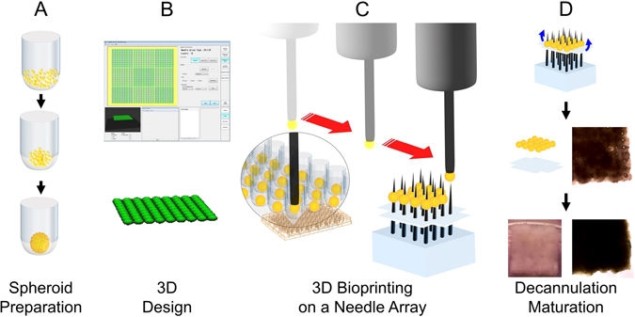
Advances in medical imaging enable bespoke tissues and organs to be developed for transplant or engraftment with remarkable resolution and definition using 3D bioprinting. The incorporation of stem cell therapies into these 3D tissue constructs is incredibly promising for the delivery of pioneering stem cell regenerative therapies. Typically, 3D bioprinting requires use of a biomaterial to aid with deposition, which can cause negative host responses. To avoid such problems, US researchers have developed a biomaterial-free cardiac patch (Scientific Reports 7 4566).
Developing a biomaterial-free cardiac patch
Heart disease affects thousands of people every year and effective repair of cardiac tissue would reduce a large medical health care burden. Researchers from the Narutoshi Hibino labat Johns Hopkins Hospital and Johns Hopkins University have devised a 3D-bioprinting procedure that allows for the biofabrication of cardiac tissue patches to deliver regenerative stem cells, without using biomaterials. The process utilises aggregated balls of cardiac cells (cardiospheroids), which are directly printed into a cardiac patch construct. The cardiospheroids are identified, picked up by a vacuum and bioprinted directly onto a needle microarray (a video of the 3D-bioprinting process used is available from JOVE). This novel method allows the patch to be constructed with cells alone and will avoid detrimental effects induced by biomaterial grafts.
Stem cell techniques for tissue regeneration typically rely on biomaterial scaffolds to provide structure and support for cells during grafting. The grafting or introduction of biomaterials to a patient induces an immune response, or can create scar tissue from the graft, potentially damaging the region of tissue intended to be repaired. Through developing a biomaterial-free graft, it is possible to avoid these detrimental factors. And by using a patient’s own stem cells it is possible to create native tissue that is fully biocompatible.
Cardiac patch integrity
3D bioprinting was crucial to the development of effective cardiac patches, with specific spatial distribution being crucial to mechanical integrity. Cardiospheres without specific placement to overlap with other cardiospheres disintegrated after removal from the needle array; although partially disintegrated regions were able to fuse back together eventually. This effect removed the structural definition of the patch, negating the advantages of using bioprinting for developing a cardiac patch of specified dimensions.
In vivo grafts
The researchers grafted patches onto rat hearts and after a week saw signs of blood vessel formation, with viable cells and red blood cells present in the cardiac patch. Tissue protein stains showed that collagen was present in the patch, indicating the deposition of a native extracellular matrix from the cells, crucial to cell integration. Further staining showed the presence of human nucleic acid in rat tissue, implying that the human cell derived patch had successfully grafted with the rat tissue.
This biomaterial-free cardiac patch was developed using pluripotent cardiomyocyte stem cells, cardiac fibroblasts and human umbilical vein endothelial cells (HUVECs), which were aggregated into cardiospheroids for bioprinting. Cardiospheroids were able to develop a functional phenotype after 48 hours, with spontaneous beating and electrical conductivity a week after bioprinting. Cardiomyocytes alone were not able to reproduce this functional phenotype.
Biomaterial-free future?
This process demonstrates a novel approach to eliminating biomaterial-induced damage. Further development of this 3D bioprinting technique in conjunction with stem cell therapies could progress biomaterial-free cardiac patches into the popular domain.



